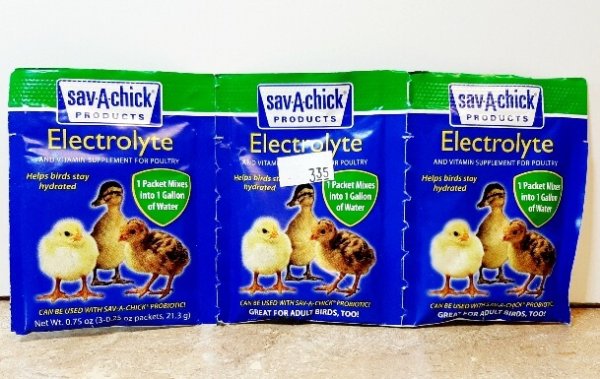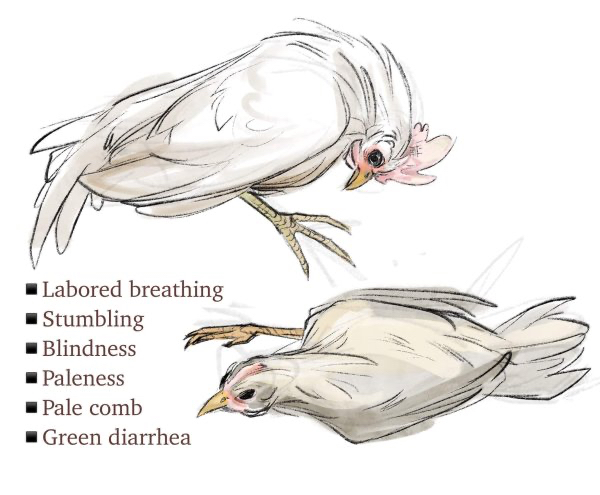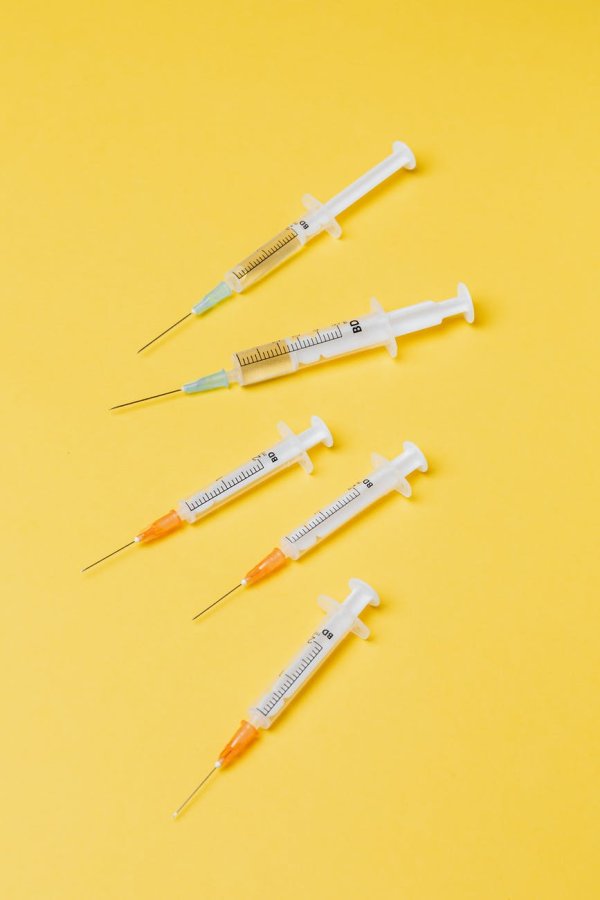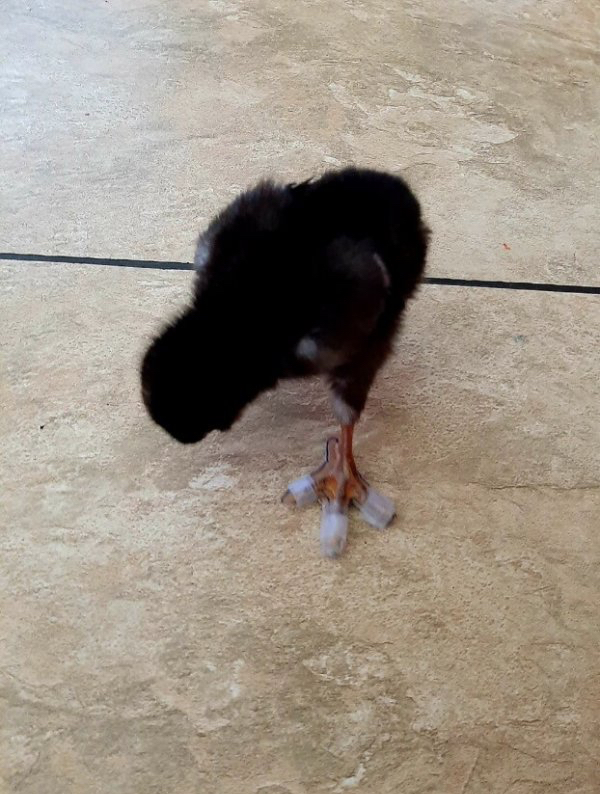Whether you just started raising chicks, or have been for many years, it’s possible you’ve seen some common chick problems. Especially if you had or have a large brood. And similar to adult birds, there are some issues they’re prone to when they’re very young. However, most are preventable. Therefore, with the proper care and attention, they should be ok.
Common Chick Problems: Dehydration
One of the most common issues day-old chicks can suffer is dehydration. But it seems to be more prevalent in cases where chicks are shipped. And some people believe dehydration in day-old chicks occurs when their body temperature exceeds 104°; normal is 103°.
How to Prevent Dehydration
Make sure the temperature in the brooder is ideal: that all of the chicks are either moving around, eating, drinking, or sleeping. But not as far away from the heat source as possible, with their wings spread out, and panting.
Treating Dehydration

Signs you have a dehydrated chick:
- Panting
- Sleepiness
- Isolation
- Refusal to eat and drink
If you have a dehydrated chick, remove it from the heat, wrap it in a towel, and administer electrolytes, with a medicine dropper if necessary, one drop at a time.
Common Chick Problems: Pasty Butt
Another common condition in new chicks is pasty or sticky butt. Actually it goes by a few names. But it’s basically when chick poo sticks to their vents or bottoms. And it can be serious if left untreated, because it can clog them up.
Preventing Pasty Butt
Make sure the temperature of their water in the brooder is ~ 95-100°. Shipped chicks are more apt to be dehydrated and get chilled. So if their first drink is cool or cold, they’re also more likely to get pasty butt. Also, be sure they are drinking well before they start eating. Further, add 2 TBSP apple cider vinegar per quart of water for the chicks’ first week of life to minimize the risk of pasting.
In addition, keep proper brooder temperatures. In the first week, you want to start at 95°. And every week reduce the temperature by 5°. But the main thing is to observe the chicks’ behavior. If they’re happy and comfortable, they will sound happy and contented. However, if they’re uncomfortable, one way or another, they’ll let you know.
Treating Pasty Bottom
Also, if you have any chicks who currently have Pasty Butt, clean them up before it hardens. Run a light stream of warm water over their bottom. Next, carefully pick off the mess with your fingers. But be mindful not to tear out any down or rip the delicate skin. However, if the poo has already hardened, you may have to pick a little off at a time, intermittently adding warm water. And when you’re done, apply Vaseline to the chick’s bottom to keep the area from being irritated and to keep poop from sticking.
If you have any chicks with frequent Pasty Butt, it could be their diet. And you might have to switch their feed.
Common Chick Problems: Coccidiosis
Coccidia are a protozoan parasite that attack the intestinal tract. And Coccidiosis is a worldwide issue, affecting large and small flocks. Though, adult chickens usually have immunity to the ones in your own yard. Which means, baby chicks could be wiped out if they’re exposed to coccidia from your chickens or someone else’s, because immunity is a process.
Symptoms of Coccidiosis in chicks include listlessness, huddling, paleness, bloody or even foamy droppings, and comparatively smaller chicks if they’re all the same age.
To Prevent Coccidiosis
- Either vaccinate day-old chicks or give them medicated feed, but don’t do both. Because, if you do both, it negates their effectiveness, and the chicks won’t be protected at all.
- Keep brooders clean and dry.
- Provide fresh, clean water daily.
- Make sure there’s enough space for the chicks.
- Provide enough ventilation to dry the litter/bedding material.
- Encourage immunity by introducing chicks progressively to your existing flock by 4 weeks old.
- Provide probiotics in chick water.
- Quarantine new flock members for at least a week. And restrict access to your birds’ yard by other chicken farmers. Also, don’t share equipment.
- And don’t toss food or treats on the ground, because it can get contaminated.
Treating Coccidiosis
Signs of coccidiosis in chicks are ruffled feathers, diarrhea that can be bloody, lack of appetite, sleepiness, and droopiness. So, if you have any chicks that you suspect have coccidiosis, then set up a separate “sick” brooder, to prevent spreading it further. Then buy Corid, which is the brand name for Amprolium, or Ampromed-P from Valley Vet. Treat the whole brood, not just the ill chick. 1/2 teaspoon per gallon of water. And it must be the only water option for 5 days.
After treatment, give the chicks a vitamin supplement like Nutri Drench.
Common Chick Problems: Marek’s Disease

This sickness is a highly contagious disease that causes immunosuppression and neurological disorders in birds. Generally young chickens are more at risk from one day old to one month. You may not see signs for 3 to 6 weeks, but symptoms of Marek’s include
- Paralysis: loss of motor control, staggered movements in either one or both legs with inability to stand or balance
- Immunosuppression: makes birds more vulnerable to other illnesses
- Wry or twisted neck when cervical nerve is involved
- Trouble eating and breathing
- Tumors in lungs, liver, kidneys, or ovaries; and skin lesions or bleeding feather follicles
- Discolored iris, deformed pupils, or blindness
- Weight loss, loose watery, and/or bright green stools
- And brain swelling
To Prevent Marek’s Disease
There’s a vaccine for Marek’s disease, however it has to be given no later than day one of hatching. But Marek’s disease isn’t 100% preventable, even with vaccines. Vaccinated birds might never get sick. But if chickens are exposed to the virus, whether or not they’re vaccinated, they can still get the virus and infect other birds.
So practice good biosecurity: Keep your coop clean, and have designated shoes for your chicken yard. And wash your hands when visiting other chicken yards. Then change your clothes after those visits. And don’t forget to quarantine birds before introducing them to your flock.
Treating Marek’s Disease
There’s no cure for Marek’s disease, however you need to separate the chick from the rest of the brood. Although, just remember there are several issues that can mimic Marek’s disease. And disinfect with a virucidal product, and wear PPE gear to protect yourself.
Common Chick Problems: Pullorum
Pullorum disease is caused by the Salmonella bacteria. And it’s also highly contagious. In addition, it can be spread from hen to baby chick through the egg. But it can also be spread by contaminated feed, water, rodents, game birds, contaminated clothing, shoes, and equipment.
Symptoms of Pullorum in chicks is lack of appetite, huddling, weakness, and white diarrhea. Furthermore, mortality is very high within the first 2 weeks, including in the incubator.
To Prevent Pullorum
Buy hatching eggs from a reliable source. And keep your coop and run clean and dry. Additionally, practice good biosecurity. Also, keep your flock’s food and water away from wild game birds.
Treating Pullorum

Currently the recommended treatment is euthanizing your flock, since it’s very contagious, and to prevent further outbreaks. And then you must disinfect with a virucidal product; remember to wear PPE. Also, in some states, you’re required to report the disease to the authorities.
Common Chick Problems: Aspergillosis
This is a fungal disease that causes pneumonia in chicks, so it’s routinely called “brooder pneumonia.” The fungus, Aspergillus, can live in feed, bedding, and even animal tissue. It produces spores, which spread through the air, only to germinate, to complete its fungal life cycle. Aspergillus spores can be inhaled by healthy birds and mammals and be completely harmless. Though, there are a couple of factors that can change this.
- A habitat with high levels of spores can overwhelm the body’s natural defenses, such as day-old chicks in brooders.
- Birds with other illnesses are more at-risk to infection.
- Situational factors, including extreme cold, high levels of ammonia or dust can stress birds and lower their immune function. And this lowers their ability to fight infections, increasing the likelihood of developing aspergillosis.
- And if you have chickens or chicks on antibiotics, they will be more vulnerable to aspergillosis, because antibiotics kill all bacteria, including ones in the respiratory tract.
Symptoms of aspergillosis included gasping, open-mouthed breathing, lack of appetite, increased thirst, drowsiness, eye swelling, blindness, and/or wry neck.
To Prevent Aspergillosis
Practice good sanitation by cleaning and disinfecting brooders and incubators. Also clean feeders and waterers and replace with new feed and fresh, clean water. Store feed in dry, clean containers, free from dust. And replace bedding regularly, especially if wet.
Treating Aspergillosis
Symptoms of aspergillosis in chicks include weakness, gasping for breath, and sudden death. So if you think you have a chick infected with aspergillosis, you should call your veterinarian. Anti-fungals, like Nystatin, are recommended for 4-6 months, but it isn’t clear whether the doses are for adult birds or not. Also, most people might not try the treatment, because it might not work. It takes a long time, and your chicks might not be able to handle it.
Common Chick Problems: Infectious Bronchitis
IBV, or Infectious Bronchitis, is an avian coronavirus that only affects chickens. And it’s commonly referred to as a cold. The virus sheds from infected birds through respiratory secretions and/or feces. And it can spread through the air, food and water, or contact with contaminated equipment and clothing. Symptoms of IBV include
- Sneezing, coughing, and rattling sounds when breathing
- Pink-eye and labored breathing, possible facial swelling with simultaneous sinus infection
- Weak, huddling under heat lamps
- Not eating while losing weight
- Depending on the strain, there can be respiratory symptoms, then weakness, ruffled feathers, wet droppings, more water intake, and then death
To Prevent Infectious Bronchitis

There are available vaccines, however there are also many strains. And then multiple boosters are required. Thus, the vaccinations are more ideal for commercial producers, not backyard enthusiasts. Though, for backyard flocks, continue to practice good biosecurity, and keep a clean coop and brooder. And sanitize equipment and shoes you use in the chicken yard. Also, quarantine birds and chicks that show signs of respiratory issues.
Treating Infectious Bronchitis
If you think you have a chick or chicks with IBV, there is no treatment, although antibiotics for 3-5 days might help fight off any secondary infections. But for brooding chicks, it’s a good idea to raise the temperature 5° till symptoms go away. And make sure ill birds aren’t exposed to other stressors. Further, add electrolytes to their water.
Birds can recover, though they can still shed the virus for up to 5 months.
Common Chick Problems: Rot Gut
Rot Gut is caused by toxins produced by Clostridium perfringens, which is a bacteria present in the intestinal tract of birds. And in normal circumstances the good bacteria keep the Clostridium perfringens population small in numbers.
But when the circumstances change in the intestines, Clostridium perfringens increases, toxins are formed, and the disease emerges. Possible causes of Rot Gut are overcrowding in the brooder, diets high in animal by-products, and previous intestinal issues, like Coccidiosis. And symptoms include listlessness, ruffled feathers, rotten smelling diarrhea, and death.
To Prevent Rot Gut
- Treat your birds like kings and queens with plenty of space, new food, and fresh, clean water daily. Also, either vaccinate the chicks for Coccidiosis or provide medicated chick starter.
- Keep the coop and/or brooder clean and well ventilated.
- And monitor your birds frequently for illnesses or anything out of the ordinary.
Treating Rot Gut
If you have a bird or chick you suspect has Rot Gut, bacitracin, penicillin, or lincomycin can be used. But the disease advances quickly, often causing permanent intestinal damage. So it’s easier to prevent it before it happens, than try to stop it once it’s in your yard or brooder.
Common Chick Problems: Mushy Chick Disease
Mushy chick disease, aka navel-yolk sac infection and omphalitis, is caused by many different bacteria. Naval deformity in newly hatched chicks makes an opening for any and all bacteria. And artificially hatched chicks are more at-risk for this than naturally hatched chicks. In addition, symptoms can be different depending on the particular bacteria, but can include
- Droopy heads
- Not eating
- Offensive odor
- Swollen or distended, leaky navel
- Open navels
- Weak, huddling under heat source
- And death often starts at hatching
To Prevent Mushy Chick Disease
This disease is totally preventable by good hygiene practice. Therefore,
- Avoid egg sweating, because bacteria can then penetrate the shell
- Clean and disinfect equipment, incubators, and brooders
- Don’t incubate dirty eggs
- Apply iodine to any unhealed navels
- And don’t transfer newly hatched chicks to the brooder until they’ve fluffed out
Treating Mushy Chick Disease
Similar to Pullorum, Mushy Chick Disease doesn’t have an agreed upon treatment. Most people humanely cull their sick birds rather than trying to treat them. And that’s because there are many different strains of bacteria that can cause it. So, if you’re dealing with Mushy Chick Disease, by the time you find out which strain you’re dealing with, the chicks might already be dead.
With that being said, add electrolytes to the water, keep the brooder bedding dry, by changing it often, and make sure there’s good ventilation.
Common Chick Problems: Splayed Legs and Curled Toes
Splayed, or spraddle, leg is basically muscle weakness in the legs and feet. It looks like the chick’s legs are to the side, making it unable to walk. And it can be caused by inconsistent temperatures during incubation, slick surfaces in the brooder, or a vitamin deficiency.
Additionally, chicks can hatch with either crooked, curled toes, or curly toe paralysis. Or they can develop crooked or curled toes after hatching. And the same things that cause splayed leg also cause toe problems. Symptoms of curly toe paralysis include a sudden appearance of chicks walking on their hocks, while chicks with crooked toes will have one or more toes that curve sideways, making them walk on the sides of those toes.
To Prevent Splayed Leg
- Provide good, high quality feed to your backyard birds. And limit the treats to snack-size portions only.
- Before incubating, calibrate a separate thermometer; and then place that in the incubator to monitor the temperature. Further, have a back-up plan in the event the power goes out.
- Avoid slick surfaces in the incubator during hatching, and also in the brooder. Provide either pine shavings, sand, paper towels, cloth, or small animal paper bedding.
- And provide adequate space and heat in the brooder. Because, if chicks get chilled, they’ll huddle together. And in some cases, chicks could stack on top of each other, hurting the ones below.
To Prevent Curly Toe Paralysis and Crooked Toes
Follow the same guidelines above, in preventing splayed legs, when also preventing curly toe paralysis and crooked toes:
- Provide high quality feed to breeding hens
- Have stable temperature in the incubator
- And avoid slick surfaces and crowding in the brooder
Treating Splayed Leg
Splayed leg is treatable, and the younger the chicks are, the better the results. The main thing is to make a leg brace to restrict movement. You can use a Bandaid, Vetrap, a hair tie, or a rubber band to bind the chick’s legs together in a normal position. But be sure the legs are in the correct position and that the brace isn’t too confining. Then change the brace every 24 hours to check how the legs are progressing. And make a new one if needed.
Treating Curly Toe Paralysis and Crooked Toes

To treat crooked toes in chicks, you need to align the toes correctly, then use Vetrap to keep them in place. Then leave the Vetrap on for ~ 24-48 hours to check your progress.
Curly toe paralysis can be cured the same way as crooked toes, with Vetrap or a Bandaid shoe, by also straightening and binding the toes. However, you need to supplement with Riboflavin, because this problem is commonly associated with that deficiency. A lot of sites will tell you to make a cardboard “shoe” if more than one toe is involved. Well, we did that with Baby Nay, our rooster whose egg got stepped on. (We had to assist his hatch 8 days early.) And one of his issues was curly toes, so we made him cardboard shoes.
Also, just a few weeks ago we hatched 14 chicks. And the last chick to hatch was kinda wobbly. I wasn’t too concerned, because they’re all kinda wobbly soon after hatching. However she didn’t improve, so I checked out her toes, and noticed she had several curly ones. But instead of making the cardboard shoes, my husband just used Coban, which is similar to Vetrap. It was a lot easier than making cardboard shoes. Plus, it worked better, because it stayed on better. Although if you want to make cardboard shoes,
- First, place a small piece of cardboard under the chick’s feet.
- Next, trace the feet.
- Then cut out the outline of the chick’s feet.
- And correctly align the chick’s toes before taping them to their shoes.
- Finally, check after 24-48 hours.
Now it’s possible you could have a more advanced case of curly toe paralysis, where the chick is actually walking on its hocks. In this scenario you would need to have a cushion, like foam, for the hocks. So you would secure the foam to the hocks with tape. And then continue making the rest of the shoe.
Signs of Healthy and Sick Chicks
This list certainly isn’t exhaustive, though I tried. But for those of you who are new to this, you might not know what healthy or sick chicks look like. Some symptoms can definitely be obvious, while others not so much. So if you hatch them yourself, whether or not the eggs came from your hens, we’ll cover that first. For the first day of hatching, chicks will be tired. And that’s completely normal, because it takes a lot of energy to hatch out of an egg. They won’t even be interested in drinking or eating for maybe 2 or 3 days. Though, personally, we start offering it by day 2.
After you have the temperature adjusted properly in the brooder, and the chicks have gained their strength, they will have energy appropriate for their ages. And they will start sounding like babies. If you’ve had kids or been around kids, you’ll know what this means. When they’re hungry, thirsty, cold, or hot, they will cry or cheep. Or when something else is wrong, someone is getting bullied, or falls over, they will cry or cheep louder. But my point is that healthy chicks eat, drink, sleep, move around, and yes, they do make noise. The older they get, the noisier they get. However they shouldn’t sound distressed.
Likewise, if you get or have chicks that you purchased or had shipped to you, then their behaviors should resemble chicks that are 2 day or 3 day old chicks: They have energy, they’re eating, drinking, sleeping, etc.
Signs to Watch Out for
But even if you hatched chicks, or had them for more than 48 hours, here are some things to keep an eye on:
- Sleepiness: sleeping a lot or just standing around
- Head twisted back over the shoulders could indicate wry neck or stargazing
- Hunched or ruffled appearance
- Bad smells: try to determine where the smell is coming from
- Chicks are huddling: indicates chicks are cold
- Diarrhea
- Bloody poo
- Blocked vent: Pasty Butt
- Rattled, gasping breathing: indicating trouble breathing
- Problems walking could be toe or leg issues
- Not eating or drinking
- Swollen, distended, mushy, smelly navel
- Panting: indicates chicks are hot
- And last but not least, if a chick is off by itself, doing any or all of these things is also a cause for concern
To Summarize
There are many common chick problems. And most, if not all, of them can be prevented by regular cleaning and disinfecting brooders and coops. Also, by providing new food and fresh clean water daily, and practicing good biosecurity. Biosecurity, according to the Poultry Extension
refers to the measures taken to prevent the introduction and/or spread of disease in a poultry flock. It is important for every poultry operation to develop, and implement, a biosecurity plan.
But then the article goes on to say more in depth about how to implement that plan. You can check it out here.
Thanks for stopping by! If you enjoyed this, please like, post a comment, share, and please don’t forget to follow!


2 replies on “Common Chick Problems”
[…] years, you’ll see many things. And sometimes it can be all at once. Like broody hens, chicks, illnesses, near death, and even revival from […]
LikeLike
[…] as the chicks are exposed to the flock, by the time they reach maturity, they will have developed immunity. Though, if you aren’t practicing good biosecurity, you can bring coccidia from another flock […]
LikeLike